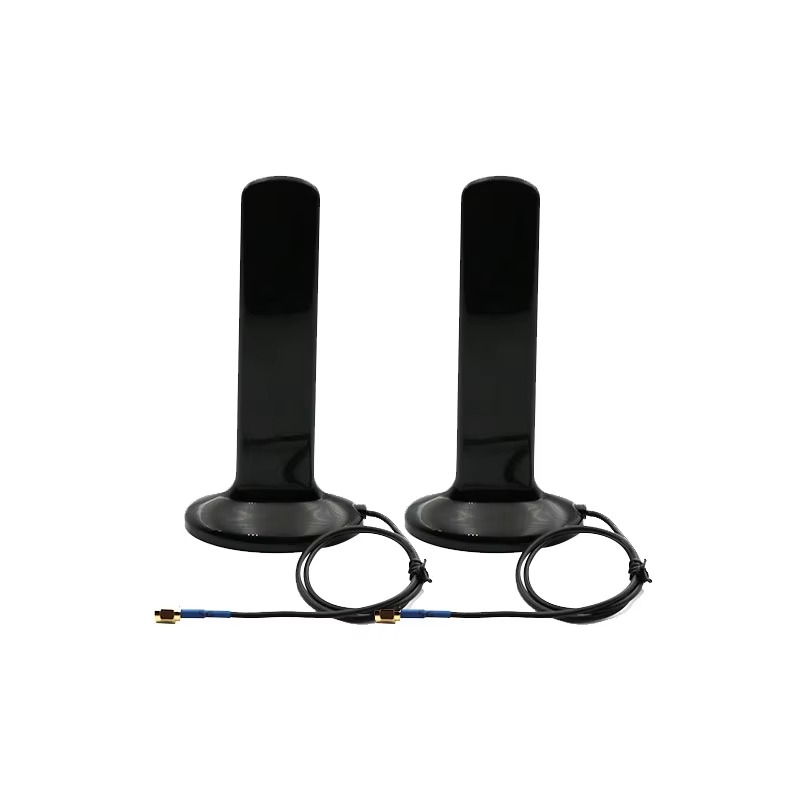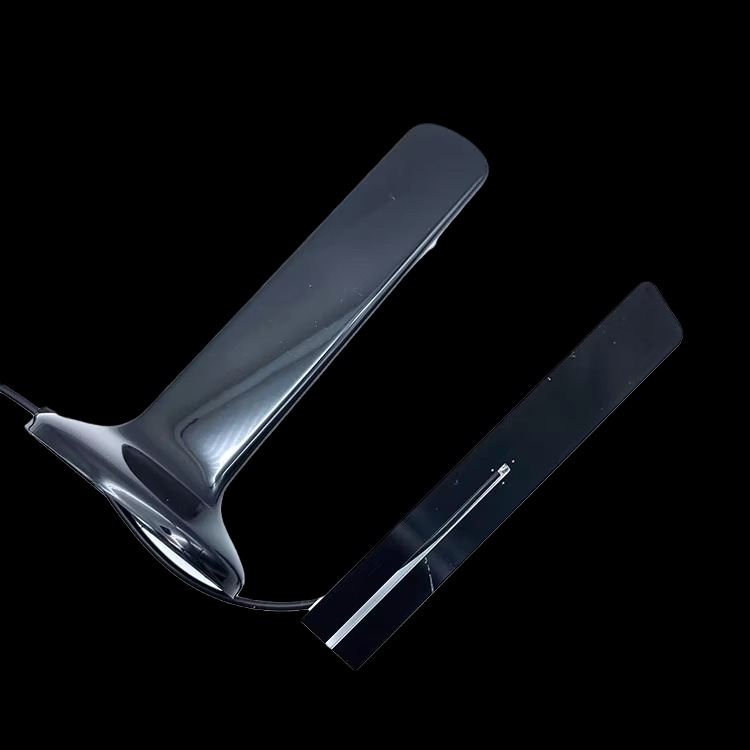At the heart of the combo antenna’s versatility is its support for multiple coaxial connectors: SMA, MCX, MMCX, HRS, and IPX. This diversity ensures compatibility with a wide array of automotive receivers, infotainment systems, and telematics devices, catering to the varied interface requirements of different manufacturers and use cases. SMA connectors, with their robust threaded design, are ideal for high-frequency applications where vibration resistance is critical, such as connecting to 4G LTE modems in commercial trucks. MCX and MMCX connectors, smaller and more compact, are perfect for space-constrained installations behind dashboards or in door panels, common in compact cars and electric vehicles. HRS (Hirose) connectors, known for their precision and reliability, are favored in premium automotive systems where signal integrity is paramount, while IPX (U.FL) connectors—ultra-small and lightweight—excel in integration with miniaturized GPS modules in advanced driver-assistance systems (ADAS). This range of connectors eliminates the need for adapters, reducing signal loss and simplifying installation, whether the antenna is paired with a factory-installed infotainment unit or an aftermarket telematics device.
The antenna’s dual gain options—28dBi and 3dBi—strike a strategic balance between signal amplification for GPS/GLONASS and 4G LTE, ensuring optimal performance across both technologies. The 28dBi gain, paired with an integrated low-noise amplifier (LNA), is dedicated to GPS and GLONASS reception, where weak satellite signals require significant amplification to overcome atmospheric attenuation and vehicle body interference. This high gain ensures that even faint signals from low-elevation satellites—critical for maintaining a position fix in urban canyons or dense forests—are amplified to usable levels, enabling centimeter-level accuracy in navigation. The 3dBi gain, on the other hand, is optimized for 4G LTE, where a lower, broader gain profile prevents over-amplification of strong cellular signals, which can cause distortion. This balance is crucial because 4G LTE signals, transmitted from nearby cell towers, are typically stronger than satellite signals, and excessive gain would introduce noise, degrading data transfer speeds. Together, these gain options ensure that the antenna performs equally well in capturing distant satellite signals and maintaining stable cellular connections, a key requirement for combo antennas.
The frequency range of 1575.42MHz (GPS L1) and 1602MHz (GLONASS G1) positions the antenna to leverage two of the world’s most widely used satellite constellations, ensuring global navigation coverage. GPS, the U.S.-operated system, and GLONASS, Russia’s counterpart, together provide near-global coverage, with overlapping signals in most regions, reducing the risk of positioning errors due to signal blockages. This dual-constellation support is particularly valuable in urban environments, where tall buildings can obstruct signals from one system, allowing the antenna to switch to the other. For example, in a dense city center where GPS signals are reflected or blocked, GLONASS signals may still be accessible, ensuring that the navigation system maintains a stable position fix. Beyond satellite navigation, the antenna’s design accommodates 4G LTE frequencies (typically 600MHz to 2600MHz, depending on the region), enabling high-speed data transfer for applications such as real-time traffic updates, over-the-air software updates, and in-vehicle Wi-Fi. This multi-frequency support makes the combo antenna a one-stop solution for both positioning and connectivity, reducing the need for multiple antennas and simplifying vehicle design.
Right-hand circular polarization (RHCP) is a critical feature that enhances the antenna’s performance in GPS/GLONASS reception, ensuring efficient signal capture even in dynamic vehicle environments. GPS and GLONASS satellites transmit signals with RHCP to counteract the Faraday effect, a phenomenon where the Earth’s ionosphere rotates the polarization of electromagnetic waves. By matching this polarization, the antenna maximizes signal absorption, ensuring that even rotated signals are captured as the vehicle turns, accelerates, or climbs hills. RHCP also minimizes multipath interference—signals reflected off buildings, road surfaces, or other vehicles—which often undergo polarization rotation, becoming left-hand circularly polarized (LHCP) or linearly polarized. This filtering effect reduces noise in the satellite signal, ensuring that the navigation system processes only valid data, a key requirement for accuracy in urban or mountainous terrain. For 4G LTE, while polarization is typically linear, the antenna’s design ensures that it maintains efficient reception of cellular signals, complementing its RHCP performance for satellite navigation.
A VSWR (Voltage Standing Wave Ratio) of ≤2.0 underscores the antenna’s efficiency in transferring signal power across both GPS/GLONASS and 4G LTE bands, minimizing loss and maximizing performance. VSWR measures the mismatch between the antenna’s impedance and the connected cable/receiver, with a lower ratio indicating better matching. For the antenna’s satellite bands (1575.42MHz and 1602MHz), the VSWR of ≤2.0 ensures that over 90% of the amplified signal is transferred to the GPS receiver, critical for maintaining the integrity of weak satellite data. In 4G LTE bands, this low VSWR ensures that cellular signals are transmitted with minimal reflection, preserving data transfer speeds and reducing interference. This consistent performance across frequencies is achieved through careful design of the antenna’s matching network, which tunes the impedance to 50 ohms—standard for RF systems—across the entire operating range. For vehicle manufacturers, this means that the antenna can be integrated into existing 50-ohm systems without additional components, simplifying installation and ensuring reliable performance.
The antenna’s coaxial cable—standard RG174 with a 3-meter length, customizable to longer lengths—balances flexibility, durability, and signal integrity, making it suitable for diverse vehicle installations. RG174 is a small-diameter coaxial cable known for its low signal loss at high frequencies, essential for transmitting both GPS/GLONASS and 4G LTE signals without degradation. Its construction includes a solid copper-clad steel center conductor, a dielectric insulator, a braided copper shield for EMI protection, and a PVC outer jacket. The braided shield is particularly important in automotive environments, where electromagnetic interference (EMI) from the engine, alternator, or infotainment system can corrupt signals. For larger vehicles, such as trucks or buses, customized longer cables (up to 10 meters) can be used, with signal boosters if necessary to maintain integrity. The 3-meter standard length is ideal for most passenger cars, allowing the antenna to be mounted on the roof or rear window—where sky and cellular tower visibility is optimal—while connecting to receivers in the dashboard or trunk. This flexibility in cabling ensures that the antenna can be integrated into any vehicle, regardless of size or layout.
A directional radiation pattern enhances the antenna’s performance by focusing signal reception toward the sky (for GPS/GLONASS) and cellular towers (for 4G LTE), reducing interference from unwanted directions. For satellite navigation, the directional pattern is optimized to capture signals from overhead satellites, minimizing noise from ground-based sources such as radio towers or other vehicles. This focus is particularly valuable in urban areas, where ground clutter can disrupt satellite signals. For 4G LTE, the directional pattern is oriented toward cellular towers, typically located on the horizon, ensuring that the antenna prioritizes signals from the nearest tower, improving data transfer speeds and reducing dropped connections. This dual-directional design—upward for satellites, outward for cellular towers—ensures that the antenna efficiently captures the signals it needs while ignoring interference, a key advantage over omnidirectional antennas that may pick up unwanted noise.
An input impedance of 50 ohms aligns the antenna with industry standards for RF systems, ensuring seamless compatibility with GPS receivers, 4G modems, and coaxial cables. Impedance matching is critical for maximizing power transfer and minimizing reflection, which can cause signal loss and interference. By adhering to the 50-ohm standard, the antenna ensures that the amplified GPS/GLONASS signals and 4G LTE signals are efficiently transmitted to their respective receivers, with minimal loss. This compatibility simplifies integration into existing automotive systems, as most GPS and cellular components are designed for 50-ohm interfaces. For example, the antenna can connect directly to a vehicle’s infotainment system, which includes both a GPS receiver and 4G modem, without the need for impedance-matching networks, reducing cost and complexity.
A DC voltage range of 3~5V ensures that the antenna’s active components—such as the LNA for GPS/GLONASS—can be powered by the vehicle’s electrical system, which typically operates at 12V (stepped down to 3~5V for sensitive electronics). This low voltage requirement minimizes power consumption, ensuring that the antenna does not drain the vehicle’s battery, even when operating continuously. The LNA, which requires this voltage to amplify weak satellite signals, is designed to consume minimal current (typically 10~20mA), further reducing power draw. This efficiency is particularly important for electric vehicles, where minimizing energy use extends battery range, and for vehicles with always-on connectivity features, such as remote tracking or stolen vehicle recovery. The 3~5V range also ensures compatibility with a wide range of receivers and modems, which may have varying power supply specifications, enhancing the antenna’s versatility.
In practical automotive applications, the Car Antenna GPS 4G LTE Combo excels across a range of use cases, from everyday navigation to advanced connected services. For personal vehicles, it enables turn-by-turn navigation with real-time traffic updates, ensuring that drivers avoid congestion and reach their destinations efficiently. The 28dBi gain for GPS/GLONASS ensures accuracy even in remote areas, while 4G LTE connectivity provides access to cloud-based mapping services and over-the-air updates for navigation software. For commercial fleets, the antenna supports real-time tracking via GPS, allowing managers to monitor vehicle locations and optimize routes, while 4G LTE enables two-way communication with drivers and access to fleet management platforms. This combination improves operational efficiency and reduces costs, whether for delivery trucks, taxis, or long-haul vehicles.
Advanced driver-assistance systems (ADAS) and semi-autonomous vehicles rely on the antenna’s precise GPS/GLONASS reception to function safely. Features such as adaptive cruise control, lane-keeping assist, and automatic emergency braking use positioning data to make split-second decisions, and the antenna’s high gain ensures that this data is accurate, even in challenging environments. 4G LTE connectivity enables these systems to access real-time data, such as road conditions or construction zones, further enhancing safety. For fully autonomous vehicles, the combo antenna is even more critical, as it provides both the precise positioning and high-speed communication needed for real-time decision-making and vehicle-to-everything (V2X) interaction.
The antenna’s robust design ensures reliable performance in extreme conditions, from freezing winters to scorching summers. Its construction—typically a weatherproof ABS or polycarbonate housing—protects internal components from rain, snow, UV radiation, and road debris, ensuring longevity even in harsh climates. The directional radiation pattern minimizes the impact of multipath interference in urban areas, while the multiple connectors and customizable cable lengths ensure flexibility in installation. Whether mounted on a compact car, SUV, or commercial truck, the antenna delivers consistent performance, ensuring that vehicles remain connected and navigational systems remain accurate.
Looking to the future, as vehicles become more connected and autonomous, the role of the Car Antenna GPS 4G LTE Combo will only grow in importance. The integration of 5G capabilities—building on the antenna’s existing 4G LTE foundation—will enable even faster data transfer, supporting applications such as high-definition streaming, real-time V2X communication, and remote vehicle control. The antenna’s dual-constellation GPS/GLONASS support will expand to include other systems such as BeiDou and Galileo, enhancing redundancy and accuracy. For manufacturers, this combo antenna represents a future-proof solution, capable of adapting to emerging technologies while meeting today’s connectivity and navigation needs.




































































 Language
Language
 En
En Cn
Cn Korean
Korean

 Home >
Home > 







 18665803017 (Macro)
18665803017 (Macro)













